 Laterally, the warm first sunlight falls on the exposed hedge. A fence post stands picturesquely in front of it. For a long time, I look out of a hide at the place illuminated with the rise of the sun. The hedgerow is still in the shade. Suddenly, there is a grey-brownish bird standing on a branch in the shadow of the hedge in the middle of the Niederer Fläming. The yellow bordered bill and an obviously not yet pronounced cheek feathering could point to a young bird. I am undecided. The bird looks slim and really striking is the chestnut brown, long tail. The creamy-white bottom is striking as well. The most common bird in this oasis in the midst of the agricultural steppe is the Eurasian Tree Sparrow (Passer montanus); immediately after comes the Greater Whitethroat (Sylvia communis). But this bird belongs in another family. Quickly I think of a young Common Nightingale (Luscinia megarhynchos), but I also do not want to exclude a young Bluethroat (Luscinia svecica) first. But a little later I really see a small thrush exposed on a haystack. Striking is a dark beard in a white throat. In addition there is a dirty grey chest drawing. Yes, that is definitely a young Bluethroat. It looks very different from the grey-brownish bird. Slimmer and bigger. It is indeed a Common Nightingale.
Laterally, the warm first sunlight falls on the exposed hedge. A fence post stands picturesquely in front of it. For a long time, I look out of a hide at the place illuminated with the rise of the sun. The hedgerow is still in the shade. Suddenly, there is a grey-brownish bird standing on a branch in the shadow of the hedge in the middle of the Niederer Fläming. The yellow bordered bill and an obviously not yet pronounced cheek feathering could point to a young bird. I am undecided. The bird looks slim and really striking is the chestnut brown, long tail. The creamy-white bottom is striking as well. The most common bird in this oasis in the midst of the agricultural steppe is the Eurasian Tree Sparrow (Passer montanus); immediately after comes the Greater Whitethroat (Sylvia communis). But this bird belongs in another family. Quickly I think of a young Common Nightingale (Luscinia megarhynchos), but I also do not want to exclude a young Bluethroat (Luscinia svecica) first. But a little later I really see a small thrush exposed on a haystack. Striking is a dark beard in a white throat. In addition there is a dirty grey chest drawing. Yes, that is definitely a young Bluethroat. It looks very different from the grey-brownish bird. Slimmer and bigger. It is indeed a Common Nightingale.
First, the bird is still covered by branches and leaves. But then it sits free in the hedge. It is obviously keen to inspect the fence post. Finally, the young bird from the hedge flies to the stake, secures the air for predators and begins to search for insects on the stake intensively. A few days later, I am looking for the same place again. The young bird seems to have disappeared. After all, an adult bird of the Common Nightingale appears. But this one is a lot more shy and comes only briefly out of the dense bushes, takes place on the fence post and is already gone again in the thicket.
The Fläming is a glacially formed ridge and at the same time a historically grown cultural landscape in southwestern Brandenburg and eastern Saxony-Anhalt. For the Niedere Fläming is a barren extensive farmland typical. The whole Fläming is a 30 to 50 kilometers wide ridge, which extends east of Magdeburg over more than 100 kilometers to the Dahme river. The Fläming was formed especially in the Saale ice age. The Fläming owes its formation to the repeated advances of the Scandinavian inland ice and is therefore built up for the most part of glacial sediments
The name of the sparsely populated derived from the Flaemings (Flemings), who populated the area in german colonization in high numbers in the middle ages. For centuries, the Fläming border area was divided between the Archdiocese of Magdeburg, the diocese of Brandenburg, the county Brehna and the Margraviate of Meissen, the future Electorate of Saxony. In 1815, after the French and Saxon defeat, the entire Fläming was incorporated into the Kingdom of Prussia.
Due to the diversity of the glacial deposits in the Fläming, the resulting soil communities are very heterogeneous. Their profitability ranges from extremely nutrient-poor and barren to very fertile.
The most fertile and fertile soils can be found in the so-called Sandlössgürtel between Bad Belzig and Dahme (town). On maps and satellite photos, this area stands out as a strikingly forest-free strip because of its agricultural use. These soils are well supplied with nutrients and easy to work with, but they can be wetted, especially in sediment bedding. The Fläming lies, like the surrounding regions, in the transition area from the oceanic climate of Western Europe to the continental climate of Eastern Europe. The climatic differences to its surroundings are small, however, clearly felt in certain weather conditions.
To cope with the growing demand for top shots of the rarer species of the Palearctic Bird-Lens is keen to enrich the range of pictures of birds you can find in the western Palearctic. Trips to remote places to capture images not only of rare birds of western Palearctic were very successful. The nice image of the blog is only a first impression, what you will find in the gallery in the “Picture Shop” very soon. Just give bird-lens.com a message, if bird-lens.com could serve you with an image needed before the new pictures are online.